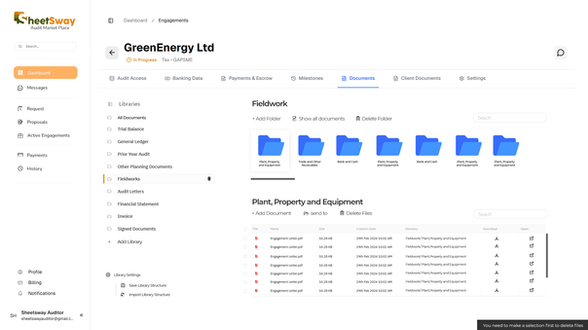

Introduction
When I first began working alongside my partner on audit-related software, I was stepping into a field far removed from traditional design. My background was in visual communication, not finance, yet the challenge of translating complex processes into something clear and intuitive immediately fascinated me.

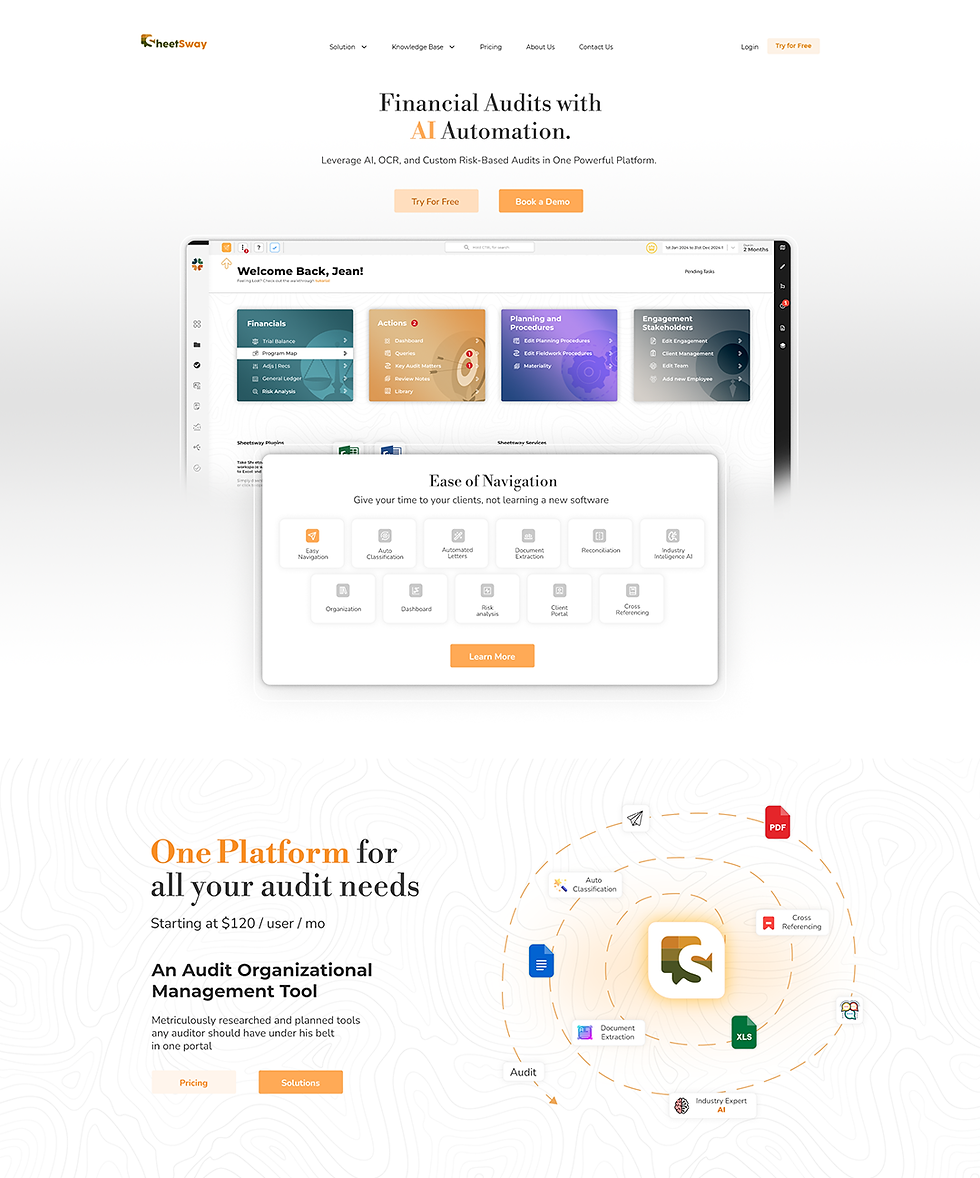


Sheetsway Saas Web Designs

Excel Sheets meets audit and communication
We worked with small outsourced teams, but most of the building happened between the two of us. It was a mix of long nights, adaptability, and stubborn determination. What we lacked in resources, we made up for in skill, focus, and the quiet persistence to turn vision into something real.
As Co-Founder and Creative Lead, I oversaw everything that shaped how the product looked, felt, and communicated. From building the interface and refining the user journey to defining our brand and story for investors. My role sat between design and management, making sure every decision stayed true to the product’s purpose and vision.


Sheetsway AI Audit Automation SOftware




Dashboard UI/UX Design
Sheetsway began as an experiment in turning complex audit work into something clear and intuitive. We saw early how AI could reshape the process and started building OpenAI-driven features before they were common.
With a small team and limited resources, I led the product’s visual direction and UX across Excel, Word, and web. My design and animation background shaped how the tool feels. I wanted a fluid and responsive build. The idea behind an audit tool is to simplify rather than impress.

Thinking big means building bigger
We Integrated leading audit tools through APIs and connected them with AI-powered workflows through our platform.
Excel Plugin
Word Plugin


We built plugins for Word and Excel because that’s where most of the real work happens. Instead of asking users to switch tools, we brought our design directly into the space they already know. Every interface was shaped to feel native with clean layouts, minimal steps, and visuals that guide without distraction. It made adoption easier and allowed the platform to blend naturally into their daily workflow.

The MarketPlace






As Sheetsway matured, we began to see a bigger divide-not only in the way audits were being done but also in how auditors were connecting with clients. The industry was fragmented, slow to modernize, and lacked a single space deliberately designed with efficiency in mind. That’s where Sheetsway Marketplace began.
End-to-end request → scope → deliverables flow
Designed for clarity under pressure.
Platform User Interface
I built the UI system upon transparency and rhythm with clean containers, soft contrast, and strong visual hierarchy in mind. Every dashboard, card, and form interaction was crafted to make dense information feel approachable while maintaining a professional, minimal atmosphere consistent with Sheetsway's core brand.
Building the marketplace showed me how much design can shape trust and how every detail matters when people rely on your product to guide them through something complex. Each screen needed to feel calm and certain, quietly helping users move forward without hesitation. Seeing that in action made me realize that good design isn’t about noise or flair, it’s about the quiet confidence that carries people from start to finish.
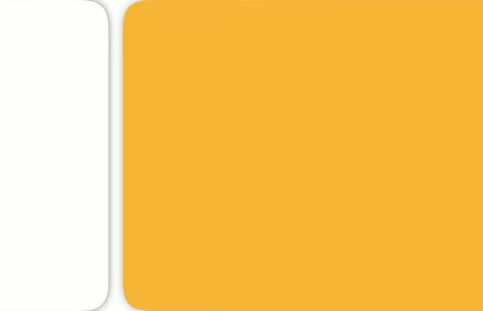

Design DIrection
Leading design and operations at Sheetsway went beyond creating interfaces. It meant organizing people, ideas, and daily communication. Most days started with Slack updates, shared Figma boards, and development calls with our outsourced teams. I led discussions, prepared meeting notes and recaps, and made sure each sprint moved forward even with people in different time zones. We kept everything connected through Notion, Trello, and Google Drive, while tools like Brevo and Mailchimp supported our communication and marketing efforts. These integrations became part of our rhythm. Adjusting to new software was necessary, but never an issue.





One of many explanatory recordings addressing amendments to the team
This process of direction and collaboration extended outside
the screen. It pushed me to take leadership in other ways,
like organizing events, coordinating private sessions, and speaking at conferences to share what we were building. It showed me that design leadership isn’t just about visuals
or systems.
I like to begin every project on paper. My desk usually fills up with sketches, notes, and small storyboards before anything reaches Figma. It helps me find flow and reasoning before I move into digital form. The whiteboards and scribbles I kept from those sessions became the backbone of the interfaces we eventually built.
 |  |
|---|---|
 |



Talks & Events



This process of direction and collaboration extended outside the screen. It pushed me to take leadership in other ways, like organizing events, coordinating private sessions, and speaking at conferences to share what we were building. It showed me that design leadership isn’t just about visuals
or systems.

Our time to Shine, Launch of our Platform
The Minster of Finance, Honored us with a speech commemorating our Launch at our event.
This process of direction and collaboration extended outside the screen. It pushed me to take leadership in other ways, like organizing events, coordinating private sessions,


The Minster of Finance, Honored us with a speech commemorating our Launch at our event.






This process of direction and collaboration extended outside the screen. It pushed me to take leadership in other ways, like organizing events, coordinating private sessions,

MArketing Efforts
Marketing for Sheetsway was built on consistency and genuine interaction. We worked with a small budget, so most of our growth came from networking, advertised articles, and steady social media posts. Being a B2B product, face to face conversations always worked better than wide campaigns, and most of our early clients came through meetings, calls, and direct outreach rather than paid advertising.
I handled the creative side of our communication, from visuals and post design to the pitch deck we shared with investors and partners. Working on these pieces taught me how marketing connects to management decisions, how stories shape expectations, and how important it is for a product to feel clear and confident in every touchpoint. Even though marketing isn’t my strongest field, it helped me understand how design supports trust and how communication guides the path a product takes.
Investor's Pitch Deck

REflections

Growing as a Designer
Working in a complex industry taught me how to think with more clarity and intention.
I learned to turn difficult ideas into simple experiences without losing their meaning.

Understanding the business side
Building a product from scratch showed me how design interacts with strategy, clients, budgets, and everyday decisions. It made me more aware of the full picture behind the work.

Carrying the mindset forward
This journey shaped how I work today. I approach new ideas with more curiosity, more care for the process, and a stronger belief that design has the power to bring clarity to any challenge.

Learning to lead
Guiding small teams, keeping communication steady, and aligning different people taught me the value of patience, structure, and calm direction. Not everyone operates the same.
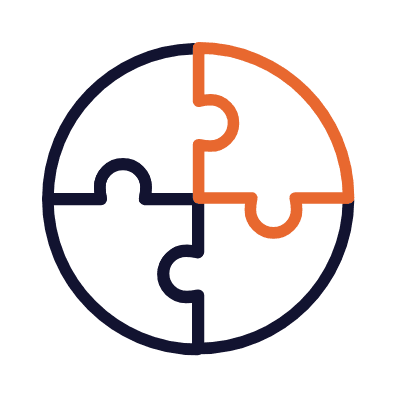
Becoming comfortable with complexity
Sheetsway pushed me into areas I never expected to touch. Compliance, workflows, timelines, and product systems all became part of my thinking and helped me grow beyond visuals.
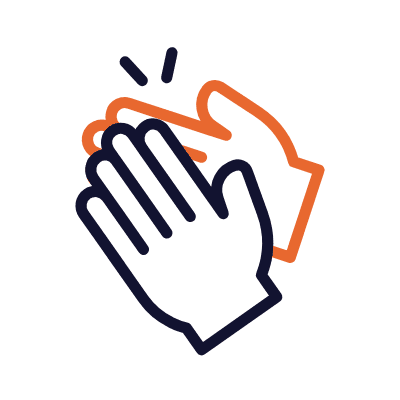
Appreciating the value of collaboration
Working closely with my partner, our clients, and every contributor taught me that the best ideas grow when people listen, support each other, while moving in the same direction.






